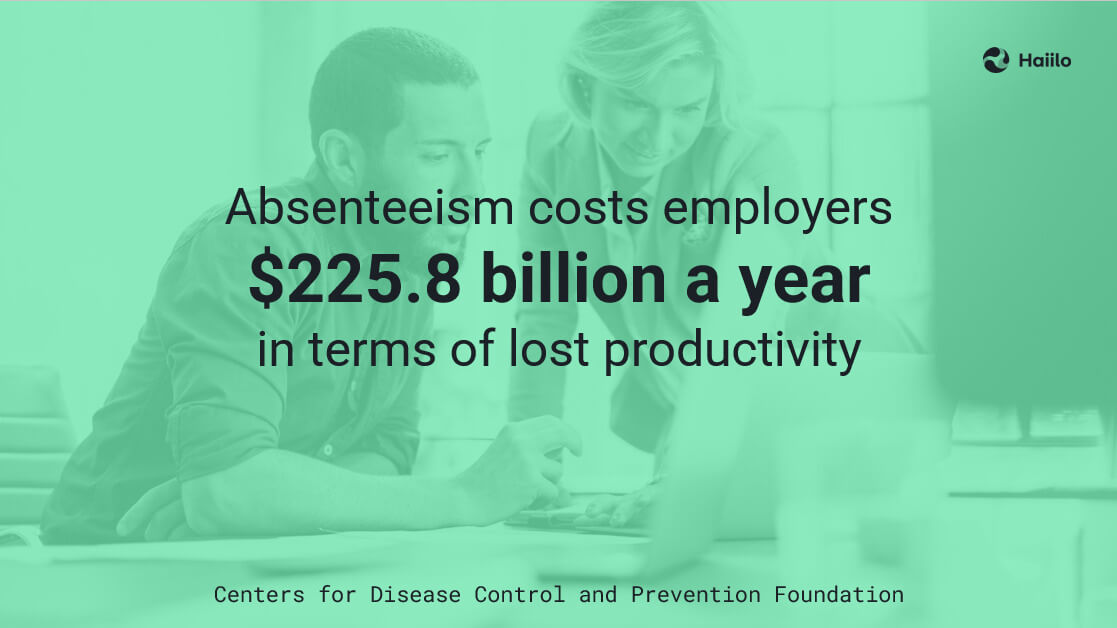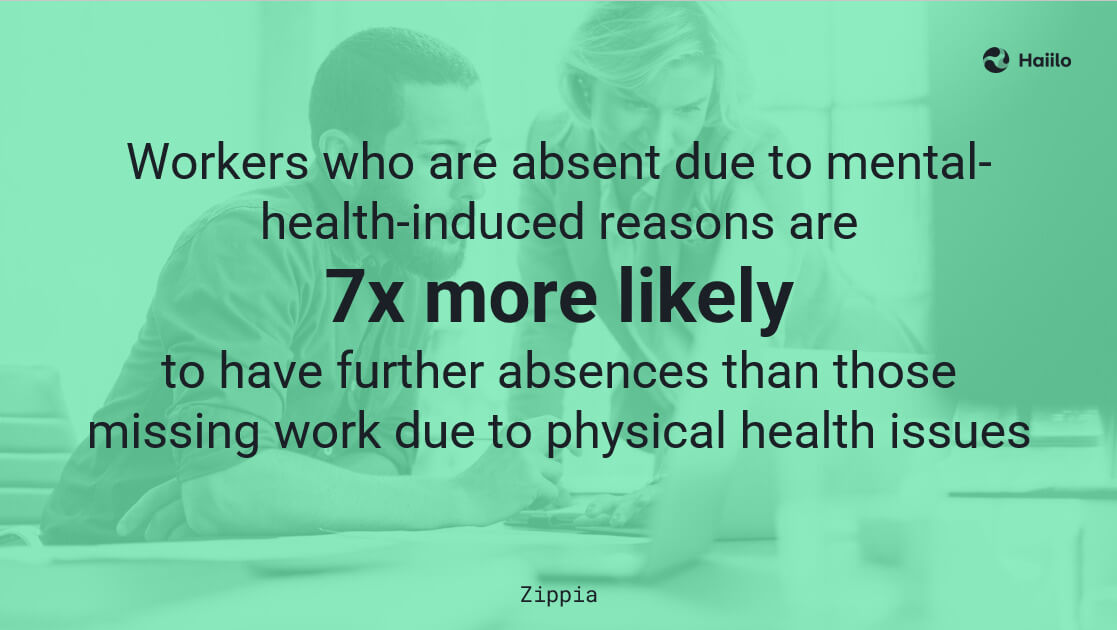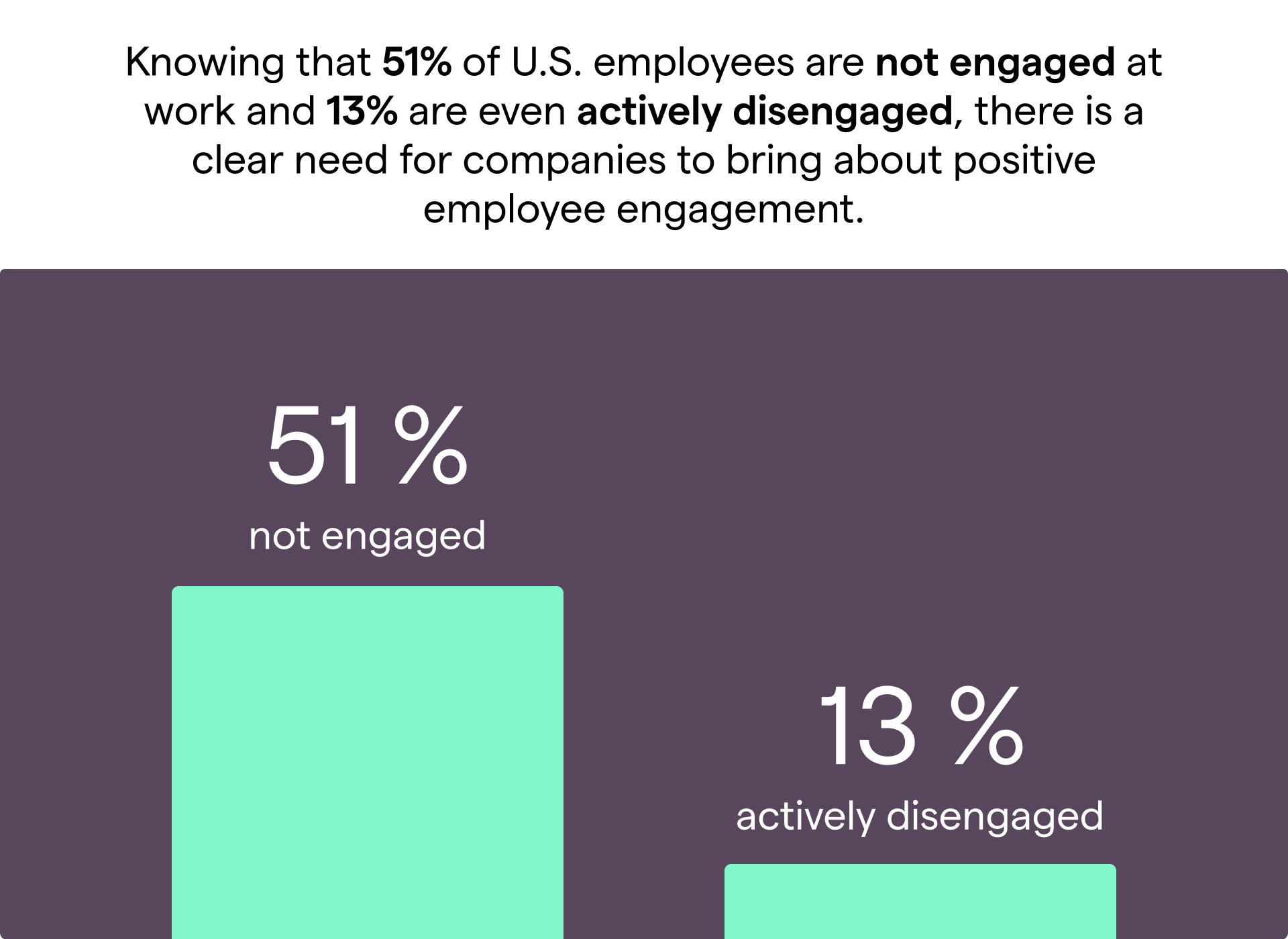Absenteeism in the workplace is one of the biggest concerns for every organization. As you will see later in this blog, absenteeism can be extremely expensive, so employers must find and address the root cause of their employees not showing up for work.
In this blog, we will define absenteeism in the workplace, name the leading causes of it, and suggest a few effective ways to fight it. At the end, we will provide a simple formula for calculating absenteeism rate in the workplace.
Absenteeism In the Workplace Defined
Absenteeism in the workplace is defined as the frequent absence of employees from work. Unlike other types of leaves, absenteeism is often unauthorized by employers. When leaving or coming late to work becomes habitual, it is also considered to be an absentee.
While not all organizations face absenteeism challenges, it is a growing concern for many employers.
In the average hourly workplace, typical unscheduled absenteeism rates range from 5% to 10%. Meaning, at any given time, 5% to 10% of the workforce is missing from work. The rate varies by industry, and industries that face more stress are more prone to higher absenteeism rates.
Reduce workplace absenteeism by increasing employee engagement with Haiilo!
How Much Employee Absenteeism Costs Employers
Employee absenteeism is costly!
The occupations most affected by employee absenteeism are the professional sectors ($24.2 billion per year), as well as the managers and executives ($15.7 billion). Physicians and farmers are among the least impacted professions (respectively $0.25 and 0.16 billion).
In the US, the cost of employee absenteeism amounts to $ 1,685 per employee each year, and this number has increased even more with COVID-19 pandemic.
According to another research, Absenteeism: The Bottom-Line Killer, unscheduled absenteeism costs companies roughly $3,600 per year for each hourly worker and $2,650 each year for salaried employees. And the Centers for Disease Control and Prevention Foundation states that absenteeism costs employers $225.8 billion a year in terms of lost productivity.

Top 6 Reasons Why Employees Miss Work
There are many different reasons why employees may miss work. However, here are the top 6 causes behind high workplace absenteeism.
1. Low motivation and engagement
The main root cause of high absenteeism in the workplace are low employee engagement and low employee motivation. Namely, highly engaged workplaces claim 41% lower absenteeism.
As the reasons behind low employee engagement can be numerous, it is important that companies analyze various engagement factors and implement appropriate engagement initiatives.
💡 Related: The New Guide for Driving Employee Engagement in the Workplace
2. Poor relationship with managers and peers
Clearly, more engaged employees are less likely to miss work. And workplace relationships play a critical role in driving employee satisfaction and engagement at work.
A Gallup survey found that office friendships boost employee satisfaction by 50%, and when people have a best friend at work, they’re seven times more likely to be engaged.
📹 Check out our webinar [WorkingX 2022] Masterclass: Leadership Engagement – the new form of networked management
3. Illness and work-related injuries
A national survey by The Hartford Financial Services Group found that 58% of blue-collar households have “a family member who has been injured on the job, requiring medical attention.”
Often, these employees are unable to work, sometimes for months.
As we will explain in the next section, workplace safety programs are critical for reducing or eliminating this cause of employee absenteeism in the workplace.
4. Work-related stress and low morale
Mental health issues, work-related stress, and low employee morale are some of the leading causes of absenteeism in the workplace. Yet, many companies are not doing enough to address this problem.
Roughly one million workers a day are absent from work due to stress. Furthermore, workers who are absent due to mental-health-induced reasons are 7x more likely to have further absences than those missing work due to physical health issues.

5. Workplace harassment and bullying
According to the Equal Employment Opportunity Commission (EEOC), harassment can include “offensive jokes, slurs, epithets or name-calling, physical assaults or threats, intimidation, ridicule or mockery, insults or put-downs, offensive objects or pictures, and interference with work performance.”
Unfortunately, too many employees experience some kind of workplace harassment. For example, according to a ZipRecruiter survey, 40% of female respondents and 14% of male respondents have experienced sexual harassment in the workplace.
Because harassment and bullying significantly impact employee job satisfaction, it is one of the main reasons why employees miss work.
6. Lack of organizational alignment
When employees are not aligned with the organization’s goals, mission, and vision, they tend to be less motivated to do their jobs. When their personal values don’t align with the core company values, they are not as engaged.
Consequently, a lack of organizational alignment can lead to increased absenteeism in the workplace.

7 Proven Ways to Fight Absenteeism In the Workplace
Now that you understand the reasons behind high absenteeism rates, it’s easier to identify ways to reduce them.
Let’s take a deep dive!
1. Encourage transformational leadership
Transformational leaders pay attention to the concerns and developmental needs of individual followers. They are good communicators and are sensitive to their team’s needs, wants, and preferences.
Yet, 85% of Millennials surveyed in the research said they would feel more comfortable if they could have more frequent conversations with management. On the other hand, among employees who strongly agree that they can approach their manager, 54% are engaged.

So to cut absenteeism rates in your workplace, consider assessing leadership styles in your company and train your managers to become truly transformational leaders.
2. Continuously measure the pulse of your employees
The best way to find the reasons for high absenteeism and prevent it is to encourage bottom-up feedback and measure the pulse of your workforce regularly.
You can do company-wide employee surveys as well as team surveys that managers can distribute to their teams.
Ideally, your employee survey solution will give you more than just raw data. Instead, it should offer valuable insights and actionable recommendations for improvement.
3. Improve employee communications
Open, transparent, and consistent workplace communications are essential for aligning employees with the ultimate business goals. And workplace alignment helps employees understand their impact on the business’s success, making them more engaged and driven to achieve better results.
Yet, 95% of employees do not fully understand the company’s goals or what is expected from them to achieve these goals. Naturally, these employees are more likely to have high absenteeism in the workplace.
4. Help your employees connect and build better relationships
Employers need to do a better job connecting their employees. This is particularly important for hybrid and remote workplaces where employees may never see each other in person.
Unfortunately, more than a fifth of Gen Zers (21%) report having no friends at work. And these workers are more likely to be absent from work.
To connect their workforce, organizations need to leverage the latest social technology. Such tools can help you improve team collaboration, boost synchronous and asynchronous communication, and make work more fun and engaging.
5. Stress the importance of workplace safety
To reduce absenteeism due to work-related injuries, it is critical to implement safety programs and continuously communicate the importance of safe behaviors at work.
Furthermore, frontline employees who often don’t have access to company email and other technology should always have a way to reach their peers and managers.
Companies should, therefore, consider implementing mobile-friendly communications tools with safety push notifications.
6. Implement an employee well-being program
As mentioned earlier, stress and poor mental health are some of the leading causes of high absenteeism in the workplace. This is why we are witnessing a rapid growth of employee well-being programs in organizations.
You can implement an internal employee newsletter with best practices to cope with stress at work and raise awareness of mental health problems.
Unfortunately, only 37% of employees say that employer-provided mental health resources can contribute to a better work environment.

7. Offer flexible work arrangements
New research from The Council for Disability Awareness (CDA) reveals that occupations with high remote work availability experienced lower rates of employee absence.
Since the start of the pandemic, many employers have witnessed the big benefit of remote and hybrid work.
How to Calculate Absenteeism Rate [+ Example]
The formula for calculating absenteeism in the workplace is pretty simple:
Absenteeism Rate = (Average # of Employees X Missed Workdays) / (Average # of Employees X Total Workdays)
Let’s look at an example.
Let’s say you want to calculate the absenteeism rate for your business in September of 2022.
- First, you need to find the average number of employees for that month. If at the beginning of the month you had 7 employees, and at the end, you had 9, your average number of employees is ([9 + 7] / 2)=8
- Then, calculate the total workdays in that month. For the purpose of this practice, let’s say your total number of workdays is 23.
- Next, find the number of workdays lost to absenteeism. If two employees missed one total day each and one employee missed a half day, you get a total of 2.5 missed days.
- Plug your numbers into the absenteeism rate formula:
Absenteeism Rate = (8 X 2.5) / (8 X 23)
Absenteeism Rate = 20 / 184
Absenteeism Rate = 0.11
Shedule a Haiilo demo to learn about how it helps other organizations improve employeeexperience and engagement and reduce absenteeism rates!










